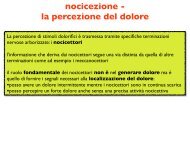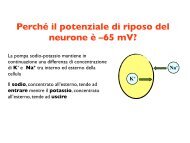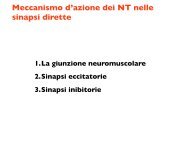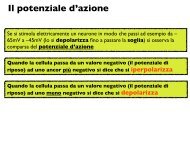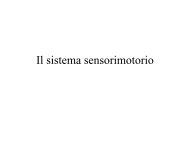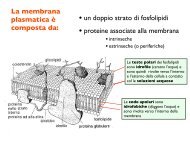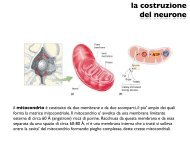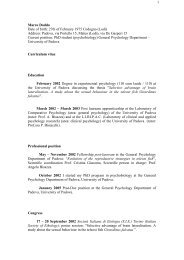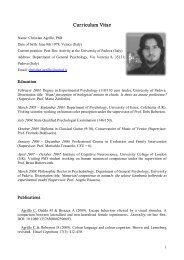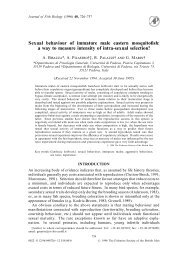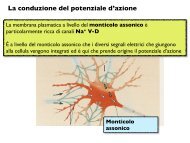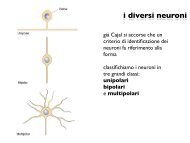Visual lateralization in response to familiar and unfamiliar ... - CPRG
Visual lateralization in response to familiar and unfamiliar ... - CPRG
Visual lateralization in response to familiar and unfamiliar ... - CPRG
You also want an ePaper? Increase the reach of your titles
YUMPU automatically turns print PDFs into web optimized ePapers that Google loves.
V.A. Sovrano / Behavioural Bra<strong>in</strong> Research 152 (2004) 385–391 387<br />
Fig. 2. Schematic representation of the mirror-test apparatus, show<strong>in</strong>g the position of the mirrors <strong>and</strong> the angles of view<strong>in</strong>g that def<strong>in</strong>ed monocular vision<br />
with the right or left eye. Data were discarded when the fish was perpendicular <strong>to</strong> the mirror (b<strong>in</strong>ocular stimulation, dotted fish) or when it formed an<br />
angle larger than 90 ◦ with respect <strong>to</strong> the closest mirror.<br />
ple t-tests. Differences between rear<strong>in</strong>g conditions (below)<br />
<strong>and</strong> time (first, second <strong>and</strong> third 5 m<strong>in</strong> of test) were estimated<br />
by analysis of variance (Anova). (Normality of distribution<br />
<strong>and</strong> any need for data transformation <strong>to</strong> account for<br />
heterogeneity of variances were checked for before apply<strong>in</strong>g<br />
Anovas.)<br />
2.1.3. Results <strong>and</strong> discussion<br />
The results are shown <strong>in</strong> Fig. 3. The Anova revealed<br />
that the ma<strong>in</strong> effect of time (first, second <strong>and</strong> third 5 m<strong>in</strong>)<br />
was statistically significant (F(2, 44) = 3.307, P = 0.046),<br />
whereas the ma<strong>in</strong> effect of <strong>familiar</strong>ity (mirror vs. conspecifics)<br />
<strong>and</strong> the <strong>familiar</strong>ity × time <strong>in</strong>teraction were not<br />
significant (F(1, 22) = 1.102, n.s.; F(2, 44) = 0.077,<br />
n.s., respectively). One-sample t-tests revealed that <strong>in</strong> both<br />
groups of fish there was a significant preference for us<strong>in</strong>g<br />
the left eye throughout the entire test<strong>in</strong>g period (first 5 m<strong>in</strong>:<br />
t(23) = 4.546, P = 0.0001; second 5 m<strong>in</strong>: t(23) = 2.053,<br />
P = 0.052; third 5 m<strong>in</strong>: t(23) = 2.295, P = 0.031), with<br />
only a m<strong>in</strong>or reduction of the bias as a function of the<br />
test<strong>in</strong>g time (see Fig. 3).<br />
The results showed that the degree of <strong>familiar</strong>ization<br />
with the stimuli provided by a mirror is not a crucial<br />
variable for the left-eye bias <strong>to</strong> occur. The strength of <strong>lateralization</strong><br />
determ<strong>in</strong>ed <strong>in</strong> these experiments was basically<br />
the same as <strong>in</strong> previous experiments <strong>in</strong> which the fish had<br />
Fig. 3. Laterality <strong>in</strong>dex <strong>in</strong>dicat<strong>in</strong>g preferences for left <strong>and</strong> right eye use (mean ± S.E.M. are shown) dur<strong>in</strong>g the first, second <strong>and</strong> third 5 m<strong>in</strong> of observation<br />
<strong>in</strong> fish reared with a mirror or with conspecifics.



